Princess Tutu
Princess Tutu disregards expectations to support the message
After dropping Revolutionary Girl Utena, Casshern Sins and Aku no Hana, I wanted to remind myself what a good anime is; this is where Princess Tutu comes in.
By presentation, it is a magical girl show like any other. The plot is about a duck, a crow, a knight and a prince that appears to be a fairy tale setting. Behind this cute facade presents the familiar yet gripping question of free will and fate.
Aside from being a classical music lover, this anime appeals to me not just on the subversive story but also the use of symphonies and play with its story. Unlike Your Lie In April where the music is not strongly tied to the story (since you may change music playing with dancing or sports or even swords), here it uses different operas and ballets that tie into the episode theme, mood and story. A more thorough musical analysis is out there but after hearing the sound track and listening to a wide range of classics, the music is a true variation on the existing piece that shows effort in the musical department. I can't say more but I know it is impressive that it just didn't edit the music straight from the public domain. I will say it is a pleasure to watch and hear specially the opening theme, Morning Grace, that sets the tone quite well.
Anyway, what I want to focus on is how framing and using the story as a fairy tale supports the theme of fate and free will and not simply as an aesthetic choice.
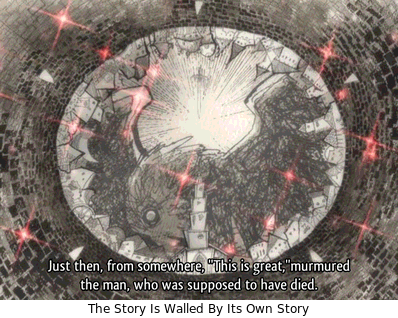
SPOILERS AHEAD
The Story
Guessing the story from the clues, it is a love story between the duck turned girl and the prince against the jealous crow princess that takes its cue from The Ugly Duckling and Swan Lake. You don't need to be familiar with them to understand the archetype or structure of a romantic story like the enchanting The Little Mermaid or the subversive Shrek or the ever undying Romeo and Juliet.
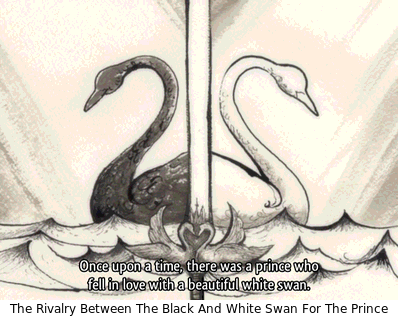
Let's first understand the overall story. This anime has twenty-six episodes or two cours that represents the two acts, short of another act to make it a three act play. The first act introduces us into the story episodic proper while the other begins its heavy deviation.
The First Act
In a nutshell, this act introduces us to the collection mission of the duck, Ahiru, turned magical ballerina girl, Princess Tutu, into gathering the lost pieces of the Prince's heart, Mytho, who cannot feel any emotion. Unlike other collection structures where gathering a key item has no bearing in a story or game such as the classic The Legend of Zelda, retrieving a piece of the heart unlocks a new emotion from the prince such as sorrow, love, fear and so on which perturbes the peaceful relationships of the cast. The first half of the anime does appear episodic that seems to culminate in the prince recovering and unlocking his heart and his love for the swan princess.
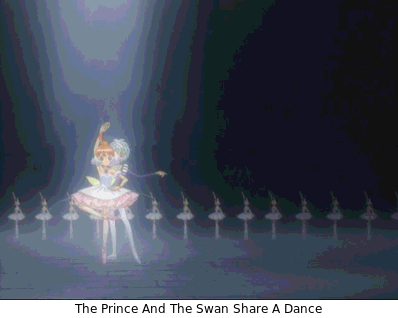
The episodic structure is used to great effect here as it continually hints at the overarching story of the anime itself: The Prince and The Raven. It tells the story of a prince shattering his heart to seal a dark Raven. Since our hapless protagonist is merely a duck, she does not know that her mission ultimately brings the Raven back into existence but the raven is not introduced within the fairy tale first act. Rather, he is saved for the second act. After the first act, a few more pieces of the heart remains, the sword of the prince is broken and a Raven to slay.
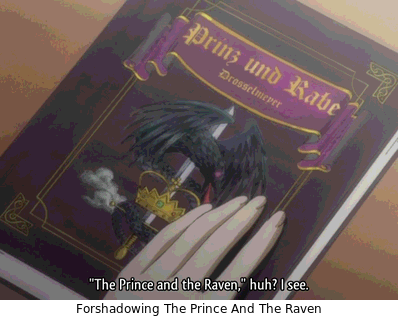
In short, the first half establishes the characters as well as subtly and subvertly fulfilling the story of a fairy tale to break it apart later with the tragic foreshadowing.
The Second Act
The story of the second act is where the story and more importantly the characters moves it beyond a magical girl anime to a great one. The story drops the episodic structure as it moves to a more character-driven story. It begins with the Prince turning into the love hungry raven by a devious ploy of the Raven in enchanting or cursing the fragment of love with his blood making friend turn foe. On the other hand, the black swan is presented as a mere victim or puppet to this malevolent being and is show greater depth along with Fakir within the second act. The pretense of a fairy tale is replaced by messing with every character, including the side ones.
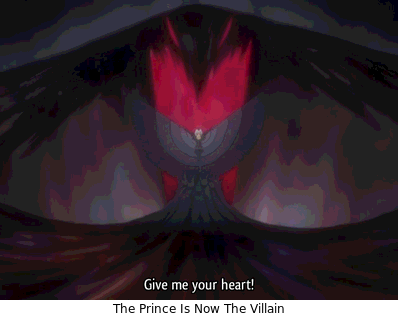
The story of the second act is fighting the fate of the book itself, that is cleverly setup in the first act. Rather, the greater fight is with the narrator, Drosselmeyer, who has orchestrated everything and is leading everyone to a tragic ending where the prince has to shatter his heart again and reset the story instead of concluding it with a happy ending. Defeating both the story villain and the story teller is a story in itself.
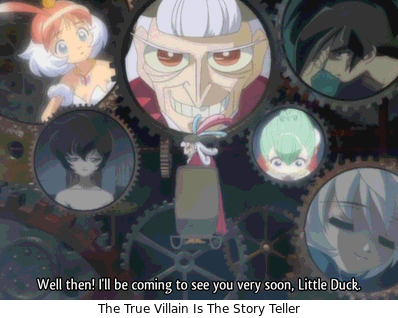
The overall theme of the anime is defying fate that we link with the characters.
The Actors
At first glance of this anime, I thought it is just another magical girl show. What let me push through despite the quacky animation, cliched use of the Nutcracker Suite is how strange the characters are setup in the beginning:
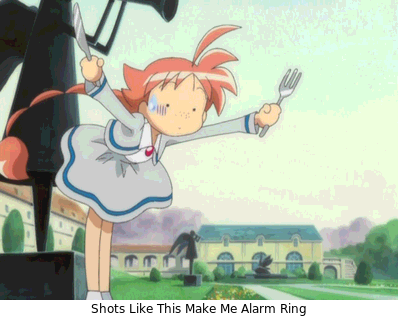
- The Prince without emotions
- Without it, it is just cliched amnesia. What is weird is that he is being saved and not the other way around. He is a bland character by default since he has no emotion that is a play on the main hero cliche itself.
- The considerate Rival
- Antagonist are almost evil by default; Rue is a better rival as she merely loves the Prince and not a jerk to Ahiru that rich girls or rivals are commonly portrayed.
- The overprotective Knight
- Fakir is not a romantic interest yet shows strong protective feelings for the Prince. This is a play on the sidekick where the trait should have gone to the love rival to make it cliche. In a sentence, he is making sure his hero-complex brother doesn't kill himself by constraining him, brotherly love indeed.
- The story teller
- Why is there a separate narrator character? Rather, why is the narrator making plays instead of simply narrating?
I like all the main characters as each do not offend me but I have a soft spot for the loveable Ahiru, the complicated Fakir and the wise puppet Edel. The characters are already nuanced in the beginning yet appearing stereotypical although I understand that they might turn people off initially if the subversion is not seen and find bland and generic characters instead.
Instead of describing each character in detail, the ending itself encapsulate everything: the Rival gets the Prince.
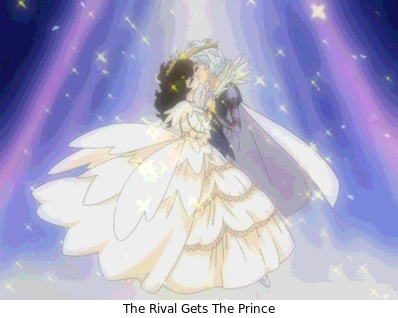
The ending itself defies the fate of the book. The Rival has true feelings of love for the Prince yet the Princess just admires him. At the end, Fakir becomes a writer who counters the influence of Drosselmeyer yet Ahiru is the same old duck who does not hook up at the end. The mold is broken for every character and stereotype once the end is reached although the ending is slightly rushed in certain aspects.
The anime presents a good job with the theme and message and it should be obvious why the anime is correct in framing the story within a story.
The Active Story Teller
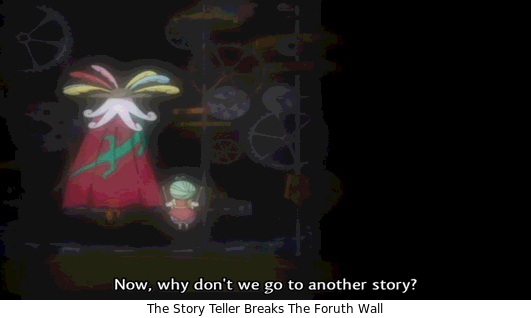
At the end of the anime, the Story Teller breaks the fourth wall by acknowledging that the story is over and instead goes to another more interesting one. This meta awareness adds to the theme of defying what is written for the characters and the story itself.
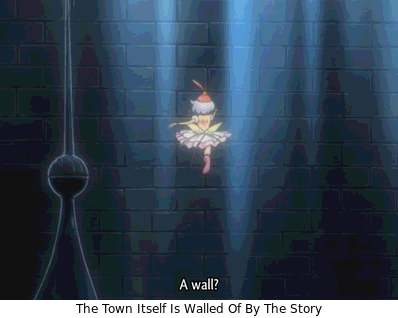
Interestingly, the town itself is part of the story since it is walled off and nobody gets out including Princess Tutu, adding to the disempowering fate their tragedy holds. If this meta layer is removed, Drosselmeyer existence and interference is out of place; rather, he becomes a Joker or Deus Ex character providing random story progression with little reason or rhyme.
If the book was the sole foreshadowing element, defying fate is a consequence of the characters will and not of the story itself. For example, stories commonly have a prophecy, a legend or internal story that foreshadows the journey or adventure that the characters ultimately ignore and defy. By cleverly using a meta-story, it also defies how the story should even playout or be. For example, even after changing the fate, the characters themselves fall into the archetype of their fate such as the heroine and hero hooking up. Here, the story is a character itself who breaks the mold along with the characters it plays on.

By making the narrator an active participant in the story, he is presented with the same question of fate and obedience. Should he make a typical fairy tale story or an captivating tragedy? Since he chooses to make it exciting, he effectively defies his fate and of the story by exercising his choice. Talking about the meta story gets messy but this is why the use of the narrator and fourth wall cleverly adds layer and depth to this story structure. It supports the question of free will, fate and obedience in such a stronger way.
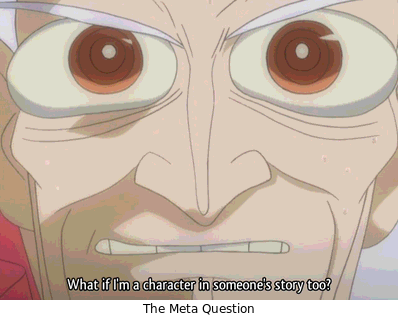
This breaking of the story also creates a story in itself that is ironic for what it is trying to do. Still, it shows that the story is secondary to the characters will and desire, not of the audience or narrator. If this is to be taken as the meta message, then write the story from the characters and not the characters from the story. This is Drosselmeyer's mistake when he focused on the tragedy and not how the characters change or alter the story.
Indeed, stories are about the actors.
Conclusion
To wrap up, using the story within a story mechanic for this anime enriches the question of fate and not merely aesthetic. I deeply appreciate this anime for not being a simple magical girl series. To understand why I enjoy this, here are the things I find cliched about magical girl series:
- Long and extraneous transformation
- Utena and Sailor Moon in particular where the transformation seems to pad out the run time after seeing it once. At least have the decency of being short as not to take time.
- Shoddy outfits
- The usual magical girl outfit is to sell merchandise and appeal to demographics. Although Princess Tutu is effectively wearing a skirt, it is presented as wholesome and innocent.
- Too colorful
- The color is too bright and colorful in a way to simply differentiate them as with Power Rangers or Pretty Cure. Having a toned down color range for Princess Tutu is such a breath of fresh air.
- Heavily Stereotyped
- Characters are heavily leaning on their personal quirks instead of being more balanced out of plot contrivances
- Cheesy Romance
- Although I don't lean toward romantic stories, I just dislike it if the romance is more about the feeling of love instead of the weight and value of their relationship.
I guess I am jaded with girly shows not having more depth or being more cute or marketable but this anime is my exception and recommendation in many ways despite the flaws. (I have seen Puella Magi Madoka Magica which some depth but I prefer the overall meaning and package of this anime.)